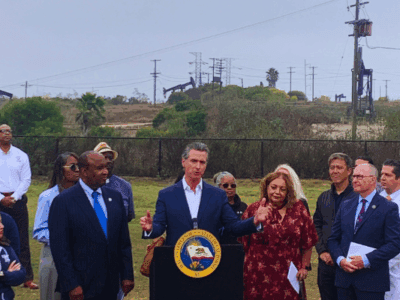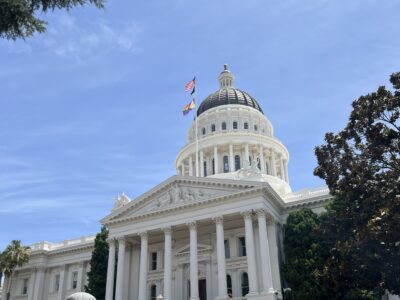Why CEQA is a Useful Tool for Environmental Justice Communities in California
A local environmental justice group’s victory in a recent California Environmental Quality Act (“CEQA”) exemption case highlights the importance of CEQA for environmental justice communities in California. After the group, Cudahy Alliance for Justice, challenged the City of Cudahy’s approval of an elementary and middle school on a hazardous waste site, Los Angeles Superior Court Judge Mary Strobel ruled that the approval was unlawful under CEQA. This post discusses the history of environmental injustice in the southeast LA community, the background of the permitting process for the project, the reasoning in the decision, and the implications of the case moving forward.
History of Environmental Injustice in Cudahy
In 2019, KIPP SoCal Public Schools (“KIPP SoCal”)—an east LA charter school—sought approval to build an elementary and middle school in Cudahy, a city 10 miles from downtown LA.
Cudahy is one of the most densely populated and highly polluted communities in the Los Angeles basin. According to CalEnviroScreen—a tool that uses environmental, health, and socioeconomic information to produce scores and rank the impacts of pollution on every census tract in the state—Cudahy is in the 97th percentile of communities most impacted by pollution in California. Although Cudahy is only 1.2 square miles, it has more than 30 potentially hazardous sites, hazardous waste handlers, and cleanup sites. Cudahy citizens also have higher rates of asthma than the statewide average as well as high rates of obesity, cancer, and heart disease. In 2012, 80 percent of Cudahy residents were low-income, and in 2014, a third lived in poverty. According to the 2010 census, over 95% of Cudahy residents identified themselves as either Hispanic or Latino, and many are immigrants.
Of the five schools in Cudahy, two were built on or immediately adjacent to hazardous waste sites. Several teachers at one of these schools reported experiencing miscarriages. In 1989, Cudahy’s Park Avenue Elementary School was closed for over a year when petroleum sludge seeped up from the ground. And in January 2020, an engine problem led the pilot of an LAX-bound plane to dump a load of jet fuel to reduce weight, which landed on another city elementary school and its students. For more than 90 years, the proposed school site at issue in this case was used to manufacture metal, using processes involving melting, casting, welding, and chemically finishing iron and steel. The site formerly housed 4,000 gallon diesel, 4,000 gallon gasoline, and additional gasoline underground storage tanks, as well as large drums of hazardous waste.
Permitting Process and CEQA Exemption
As background, CEQA’s purposes are (1) to inform the public and decisionmakers of all the potential environmental consequences of proposed discretionary projects, and (2) to mitigate or eliminate significant environmental effects of public agency decisions, where possible. CEQA requires state and local governmental entities to “give major consideration to preventing environmental damage” by conducting environmental review prior to permitting discretionary projects and by requiring feasible mitigation to reduce or eliminate environmental impacts.
In 2019, the developer of the project submitted a Development Review application to the City of Cudahy (“the City”) on behalf of KIPP SoCal, requesting approval of the KIPP Pueblo Unido Public School Project (“the Project”). The Project is a proposed 67,148 square foot K-8th public charter school campus, including a 99-space subterranean parking structure. KIPP SoCal’s own environmental site assessments, provided to the City as part of the approval process, revealed that there were “significant hazardous areas of concern” on the site which “pose a[n]… exposure and contact risk to the children and general public human health.” These areas of concern included arsenic at 200 times California’s exposure limit for school or residential areas, volatile organic compounds, and potential lead and asbestos contamination. The City initially rejected the project because of these environmental issues as well as widespread public outcry.
However, after the public hearing on September 15, 2020, the City Council determined that the Project was ministerial and thereby exempt from CEQA, made the findings required for approval of the Development Review application, and approved the Project. A ministerial project only requires “conformance with a fixed standard or objective measurement and requires little or no personal judgment by a public official as to the wisdom or manner of carrying out the project.” By contrast, discretionary projects are those which require “the exercise of judgment or deliberation when the public agency or body decides to approve or disapprove a particular activity. The key question is whether the public agency can use its subjective judgment to decide whether and how to carry out or approve a project.” Importantly, ministerial projects are not subject to CEQA review and therefore do not require an Environmental Impact Report (“EIR”). An EIR would disclose and analyze a wide range of environmental impacts on the surrounding area and require project approval to incorporate feasible measures to mitigate significant impacts.
The Lawsuit
In 2020, after the City Council approved the Project, Cudahy Alliance for Justice, comprised of local educators and parents, as well as local activists and community leaders Susie de Santiago and Aydé Bravo Berrios, filed a lawsuit to stop the City of Cudahy from permitting KIPP SoCal to build KIPP Pueblo Unido without CEQA review. On January 13, 2022, the Court agreed that the Project was not exempt from CEQA, and issued a writ directing the City to set aside its approval of the Project development and conduct CEQA review.
Petitioners argued that the City prejudicially abused its discretion in determining that the Project was ministerial and so exempt from environmental review. They contended that the Project was discretionary under the Cudahy Municipal Code (“CMC”). According to Petitioners, the Court did not need to look beyond the plain language of the City ordinance to determine whether the City abused its discretion because section 20.84.180(B) of the CMC states that applications for Development Review “are considered discretionary projects subject to the requirements of CEQA.”
Judge Strobel applied a functional test that courts have developed to refine the distinction between ministerial and discretionary projects. This functional test focuses on the question of whether the relevant approval process allows the government to shape the project in any way by requiring modifications which could respond to any of the concerns that might be identified by environmental review. If the agency is empowered to disapprove or condition approval of a project based on environmental concerns that might be uncovered by CEQA review, the project is discretionary.
The CEQA Guidelines encourage agencies to classify ministerial projects on either a categorical or individual basis. According to Guidelines §15268(c), “[e]ach public agency should, in its implementing regulations or ordinances, provide an identification or itemization of its projects and actions which are deemed ministerial under the applicable laws and ordinances.” In approving the Project, the City failed to provide an explanation for its determination that the Project is ministerial. And while the City may not have been required by CEQA to identify all Development Review permits as discretionary, the Court noted that it is highly significant that the City decided to do so. The plain language of the relevant CMC provisions provided persuasive evidence of the City’s intent that all applications for Development Review, including for major non-residential projects, should be considered discretionary and subject to environmental review under CEQA.
The Court’s interpretation of Protecting Our Water & Environmental Resources v. County of Stanislaus (“POWER”) was key to its decision. POWER posed the question of whether, in at least some circumstances, a Department of Water Resources permit standard required the County of Stanislaus to exercise discretion, and whether its classification of all such permits as ministerial was permissible in light of this possibility. Judge Strobel rejected Respondents’ assertion that “classification of a permit as categorically discretionary does not foreclose a determination that issuance of a particular permit is ministerial.” Rather than deliberating “whether an activity (in that case, issuance of well permits) can be categorically determined to be discretionary or ministerial,” as Respondents asserted, the POWER court considered whether an agency could classify all permits as ministerial even where the ordinance requires the agency to exercise discretion in some cases.
The Court ultimately agreed with Petitioners’ argument that both the plain language of the CMC, as well as the requirement it imposed on City staff to exercise discretion to grant a Development Review permit and modify or condition the Project to respond to environmental concerns, demonstrated that the City abused its discretion. Additionally, the Court found that applying the ministerial exemption in this case would conflict with CEQA’s goal of affording the fullest possible protection to the environment, given that the Project involves major non-residential construction near residential uses and has identified “significant hazardous areas of concern.”
Now that Cudahy Alliance for Justice and its allies have secured this victory, the City of Cudahy must complete an EIR for the project and require KIPP SoCal to properly clean up the site with oversight from the Department of Toxic Substances Control—a state agency tasked with ensuring proper remediation for hazardous waste sites.
Implications of the Case
This critical win is a testament to the strong, united community opposition of Cudahy residents. It “is an important step in holding KIPP and the City of Cudahy accountable for protecting the environment, and ensuring the site is safe for students, educators, and community members,” said Elise Cossart-Daly, counsel for Petitioners. The decision affirms the notion that CEQA is more than a mere technical hurdle; it imposes substantive duties on agencies and governmental entities to maintain a clean and safe environment for the people of California. CEQA is a particularly important tool for environmental justice communities, which are disproportionately burdened by multiple sources of pollution. It is crucial to note, however, that communities of color oftentimes do not receive the same legal protection as people in more affluent, whiter communities. For this reason, courts have an important role to play in interpreting CEQA’s requirements to protect overburdened communities.







Reader Comments